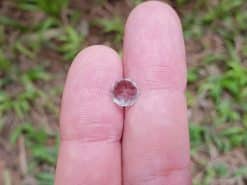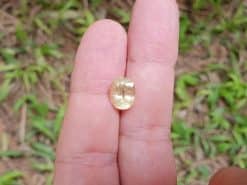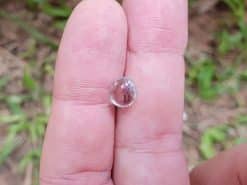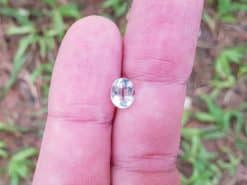Amblygonite

Amblygonite crystal gemstone meaning and properties. Multicolor color mineral. As jewelry, Amblygonite stone is often set on ring.
Buy natural amblygonite side in our shop
The stone name comes from Greek “crooked angled”, referring to mineral’s triclinic crystals. It is a fluorophosphate mineral, (Li,Na)AlPO4(F,OH). The chemical compition is lithium, also sodium, aluminium, phosphate, fluoride and hydroxide. The mineral occurs in pegmatite deposits.
We can confuse it with albite or feldspars. Its density, cleavage and flame test for lithium are diagnostic. It s forms a series with montebrasite, the low fluorine endmember. Geologic occurrence is in granite pegmatites, high-temperature tin veins, and also greisens.
It occurs with spodumene, apatite, lepidolite, tourmaline, and other lithium-bearing minerals in pegmatite veins. It contains about 10% lithium. It’s also a source of lithium for industry. The chief commercial sources have historically been the deposits of California and France.
Gemstone classification
Transparent gem is now in gemstone classification. As a gemstone set into jewelry, it is vulnerable to breakage and abrasion from general wear, because its hardness and toughness are poor.
Sources
The main sources for gem material are Brazil and also United States. We can found quality specimens in Australia, also in France, Germany, Namibia, Norway and Spain.
Amblygonite identification
- Refractive Index: 1.578 to 1.646
- Optical Character: Biaxial/+, –
- Birefringence: 0.020 to 0.030
- Density: 2.98 – 3.11, Average = 3.04
- Crystal System: Triclinic
- Hardness: 5.5-6
- Luster: vitreous, pearly
- Dispersion: 0.014 to 0.015
History
The mineral was discovered in Saxony, by August Breithaupt in 1817. He named this stone from the Greek amblus, blunt, and gonia, angle. Because of the obtuse angle between the cleavages.
Later it was found at Montebras, Creuse, France, and at Hebron in Maine; and because of slight differences in optical character and chemical composition the names montebrasite and hebronite have been applied to the mineral from these localities.
It has been discovered in considerable quantity at Pala in San Diego county, California; also Caceres, Spain; and another to the Black Hills of South Dakota. The largest documented single crystal of amblygonite measured 7.62×2.44×1.83 m3 and finally weighed 102 tons.
Amblygonite crystal gemstone meaning and healing properties benefits
The following section is pseudo scientific and based on cultural beliefs.
The stone has a number of beneficial healing properties. Their vibration is said to help headaches, irritable bowel syndrome and stomach and digestive problems, and may also help the body to mend broken bones and to aid with the healing of bone disorders.
FAQ
How is amblygonite formed?
The stone forms a series with montebrasite, the low fluorine endmember. Geologic occurrence is in granite pegmatites, high-temperature tin veins, and greisens. The gem occurs with spodumene, apatite, lepidolite, tourmaline, and other lithium-bearing minerals in pegmatite veins.
What is amblygonite used for?
A stone that enhances the creativity, brings peace, and releases stress. The crystal ring is essential if you’re creative. It enhances the special gifts, since it may encourage you in allowing the inner brilliance you have to prosper and flourish..
What is amblygonite gemstone?
Gemstones are usually pale straw yellow. Although they are too soft and cleavable to make good ring stones, collectors prize them if they show darker colors. Large faceted stones are extremely rare.
Where is amblygonite found?
The stone is mostly found in Penig, Chemnitz, Saxony, in east central Germany. However the best gem quality is found in Minas Gerais, particularly around Aracui, in southeast Brazil, as well as in Sakangi, Mogok, Mandalay, in central Myanmar.
Is amblygonite rare?
Extremely rare, transparent crystal has been faceted and used as a gemstone. The main, albeit sporadic, sources for gem-quality are Brazil and the USA.
Natural amblygonite for sale in our gem shop
We make custom made amblygonite jewelry as engagement rings, necklaces, stud earrings, bracelets, pendants… Please contact us for a quote.
















